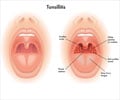The microdebrider technique had the lowest overall complication rate when compared to the other two techniques, according to a review of three different surgical techniques
The microdebrider technique had the lowest overall complication rate when compared to the other two techniques, according to a review of three different surgical techniques commonly used for tonsillectomy. The results are shown in new research published in the June 2010 issue of Otolaryngology – Head and Neck Surgery.
Tonsillectomy is among the oldest and most commonly performed procedures in the pediatric population. Approximately 530,000 outpatient pediatric adenotonsillectomies (which include removal of the adenoids) are performed annually in U.S. hospitals. Despite the frequency of the procedure, there is no universally accepted "ideal" method. And although generally considered a safe procedure, tonsillectomy has significant potential for complications, especially in the pediatric population. Potential major complications include: post-operative hemorrhage, dehydration, and anesthetic and airway risks. Common post-operative complaints like odynophagia (painful swallowing), otalgia (ear pain), fever, and uvular swelling tend to prolong the pediatric patient's recovery.The objective of the new study was to determine if surgical technique is associated with a patient experiencing post-surgical complications after undergoing adenotonsillectomy, and to identify patients who may be "at-risk" for major complications after such surgery.
The case-controlled study included 4,776 patients age 1 to 18 years, undergoing adenoidectomy, tonsillectomy, or adenotonsillectomy over a 36-month period. The three techniques compared were microdebrider, coblation (a controlled, non-heat-driven process using radiofrequency energy), or electrocautery (process of destroying tissue by heat conduction from an electrically heated metal probe).
Study results showed a statistically significant difference in the risks of developing a major complication of having a tonsillectomy with coblation, electrocautery, or microdebrider. The microdebrider had the lowest overall complication rate of 0.7 percent, versus that of the coblator, 2.8 percent, and electrocautery, 3.1 percent. The authors reported that those who had tonsillectomies via coblation were 3.9 times more likely to have complications than those who had tonsils removed via microdebrider. Additionally, complications for patients who had tonsillectomies via electrocautery were 4.4 times more likely than those who had tonsils removed via microdebrider.
"Questions will remain regarding what is the best procedure," said study author Craig S. Derkay, MD. "However, an important point is that that no matter which surgical technique was used for removal of the tonsils in the study, our results demonstrate an acceptable level of safety across all procedures."
In terms of risk factors for post-surgical complications, patient's age proved to be a significant aspect in their treatment and outcome following tonsillectomy. When looking at the average age of dehydration and post-tonsillectomy hemorrhage, the authors observed that the younger patients had more episodes of dehydration, while older patients tend to have more episodes of post-tonsillectomy hemorrhage.
 MEDINDIA
MEDINDIA


 Email
Email





